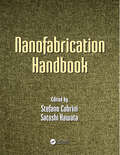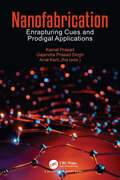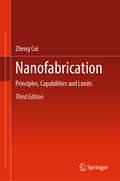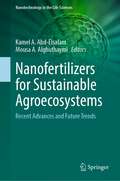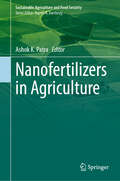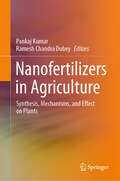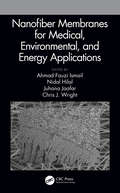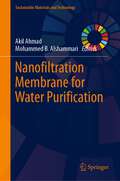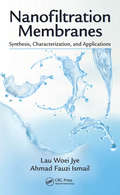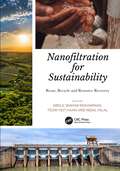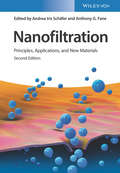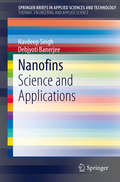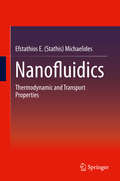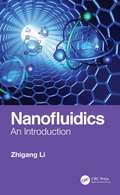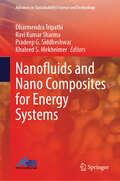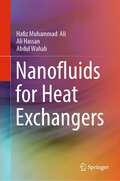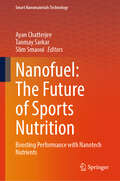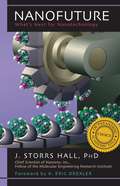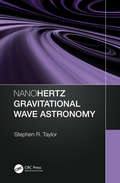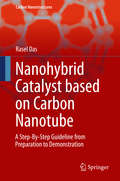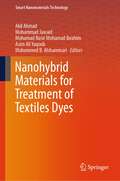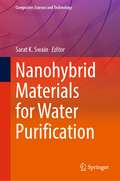- Table View
- List View
Nanofabrication Handbook
by Satoshi KawataWhile many books are dedicated to individual aspects of nanofabrication, there is no single source that defines and explains the total vision of the field. Filling this gap, Nanofabrication Handbook presents a unique collection of new and the most important established approaches to nanofabrication. Contributors from leading research facilities and
Nanofabrication: Enrapturing Cues and Prodigal Applications
by Kamal Prasad Gajendra Prasad Singh Anal Kant JhaNature, with its unassuming yet prodigious character, unfolds its assembly and adaptability guided by the principles of thermodynamics and supramolecular chemistry. Every entity in nature, regardless of its form, adheres to these fundamental principles. From individual metabolites to ordinary molecules, each possesses inherent potential for nanomaterial synthesis. This book meticulously compiles diverse green approaches that highlight nature's synthetic prowess and its lavish abundance in nanomaterial synthesis, showcasing potential applications. It unveils the lucrative pathways nature provides for cutting-edge advancements in synthetic methodologies and material applications.
Nanofabrication: Principles, Capabilities and Limits
by Zheng CuiNanofabrication: Principles, Capabilities, and Limits provides a practical guide to nanofabrication technologies and processes. It was first published in 2008 and is now in an updated third edition. The book introduces readers to the fundamentals and recent developments in nanofabrication techniques, with chapters covering optical lithography, electron beam lithography, and nanoimprinting lithography, as well as nanofabrication by focused ion beams, scanning tips, self-assembly, and nanoscale pattern transfer by etching and deposition. There is also a chapter describing various tricks that enable the fabrication of nanostructures that would otherwise be impossible using traditional methods. The unique feature of this book is that each technique introduced is not only about its capabilities but also its limits so that the readers are fully aware of the best options to choose from a toolbox of nanofabrication processes covered in the book.
Nanofertilizers for Sustainable Agriculture: Assessing Impacts on Health, Environment, and Economy
by Pankaj Kumar Ramesh Chandra DubeyThis book covers the use and impacts of nanofertilizers from a sustainable agriculture perspective and together with its companion book “Nanofertilizers in Agriculture: Synthesis, Mechanisms, and Effect on Plants” serves as an indispensable resource for researchers, agronomists, and policymakers exploring sustainable agriculture with nanotechnology. Divided into 4 main sections, the book begins with a critical overview of the impact of nanofertilizers on the ecosystem, their toxicity, and implications on the protection of the environment, followed by a section devoted to the use of nanoparticles for disease management. Subsequent sections offer a perspective of nanofertilizers in soil and water health, and economical analysis. In this book, readers will find chapters covering topics such as the toxicity of nano fertilizers due to overuse, their role in controlling soil-borne fungal pathogens, and their potential for safe and sustainable agriculture with a focus on organic farming. Readers will also gain insights into nanotechnology applications for plant pathogen detection, viral disease management, and nematode disease control. The authors present an expert analysis of the impact of nano fertilizers on soil properties, crop productivity, groundwater, and soilless agricultural systems. This book is particularly valuable for researchers in agricultural science, and it is also relevant for environmental scientists interested in sustainable practices and nanotechnologists exploring agricultural applications. Practitioners such as farmers and agronomists will find practical insights for integrating nanotechnology into their work. This volume is a must-read for anyone invested in the future of sustainable agriculture.
Nanofertilizers for Sustainable Agroecosystems: Recent Advances and Future Trends (Nanotechnology in the Life Sciences)
by Kamel A. Abd-Elsalam Mousa A. AlghuthaymiLarge-scale chemical fertilizer application causes irreparable damage to soil structure, mineral cycles, soil microbial flora, plants, and other food chains across ecosystems, culminating in heritable mutations in future generations of consumers. A better way forward is the use of nanofertilizers to focus on macro elements (N, P, K), as switching to nanofertilizers may result in large environmental benefits by replacing the majority of these nutrients. Furthermore, the biosynthesis of nanomaterials using bacteria, algae, yeast, fungus, actinomycetes, and plants has opened up a new avenue of research in the production of inorganic nanoparticles as ecologically friendly fertilizers. Nanofertilizers should also attain increased efficiency because of a several-fold increase in the surface-to-volume ratio of nano-forms of nutrients and their suitability for foliar application, where environmental losses are further reduced. Nanostructured fertilizers can also improve nutrient use efficiency through strategies such as targeted distribution and progressive or controlled-release as they can precisely release their active molecules in response to environmental cues and biological demands. Recent research shows nanofertilizers can increase agricultural productivity by speeding up seed germination, seedling growth, photosynthetic activity, nitrogen metabolism, and carbohydrate and protein synthesis. The potential agricultural benefits of nanofertilizers, their modes of action, and the fate of nanomaterials in soil are all discussed in this book. It also covers nanofertilizer formulation and delivery, applications, uptake, translocation, and their fate in plants, as well as their impact on plant physiology and metabolism. Nutrient nanoformulation is a valuable method that has the potential to alter the agricultural sector and provide solutions to current and future concerns for sustainable and climate-sensitive crops
Nanofertilizers in Agriculture (Sustainability Sciences in Asia and Africa)
by Ashok K. PatraThis book explores the role of nanofertilizers in sustainable and efficient agricultural practices of the 21st century. It covers the various aspects of nanofertilizers, spanning their production, characterization, and performance. It also elucidates their mechanism of nutrient release, interaction with soil microorganisms and uptake by plants. It discusses the feasibility of large-scale production, cost-effectiveness, and regulatory considerations surrounding nanofertilizers. By presenting real-world case studies and success stories, it offers valuable insights for farmers and agricultural stakeholders looking to adopt this innovative technology. This book serves as a valuable educational resource for researchers working in agricultural science, environmental science, and related fields. It is also important for scientists, agronomists, and policymakers seeking to harness the transformative power of nanofertilizers.
Nanofertilizers in Agriculture: Synthesis, Mechanisms, and Effect on Plants
by Pankaj Kumar Ramesh Chandra DubeyThis book covers the role and effects of nanofertilizers in agriculture and together with its companion book “Nanofertilizers for Sustainable Agriculture: Assessing Impacts on Health, Environment, and Economy” serves as an indispensable resource for researchers, agronomists, and policymakers exploring sustainable agriculture with nanotechnology. The book outlines the synthesis and formulation of nanoparticles tailored for agricultural applications and discusses the impact of nanofertilizers on crop well-being and soil fertility, including the pivotal role of plant growth-promoting microorganisms in nanoparticle-mediated agriculture. Divided into four sections, the book begins with an introduction to the relevance and specificities of nanotechnology in agriculture, including nonfertilizer synthesis and formulation, followed by a section dedicated to rhizosphere microorganisms and the impact of nanofertilizers in agricultural systems. Readers will learn about the impact of nanofertilizers on crop well-being and soil fertility, including the pivotal role of plant growth-promoting microorganisms in nanoparticle-mediated agriculture. The subsequent section of the book is devoted to the mechanisms of action of nanofertilizers, namely the ones governing the release, absorption, and translocation of nanonutrients in soil, and discusses the potential of biocatalysis in nanofertilizer development. The final section of the book discusses crop productivity and biofortification while unravelling the nuanced effects of nanoparticle doses, shapes, sizes, and compositions on crop yields and physiological activities. In this section, readers will also find diverse applications of nanofertilizers in stress tolerance, salinity, and environmental stress mitigation.
Nanofiber Membranes for Medical, Environmental, and Energy Applications
by Ahmad Fauzi Ismail, Nidal Hilal, Juhana Jaafar and Chris J. WrightThis book focuses on the nanofiber membrane’s fabrication, characterization, and performance for medical, environment and energy applications. Topics include polymer, inorganic and composite-form nanofiber membrane materials. Top Research teams from varied disciplines and continents outline applied nanofiber membrane fabrication techniques and characterizations. Promising nanofiber membranes for improving and enhancing technologies used in drug delivery, wound healing, tissue engineering, water and wastewater treatment and purification, gas separation and purification, air purification, and fuel cells are discussed along with the likely path forward for commercial usage. Key Features: Shares the most recent discovery solutions from experts all over the globe for the numerous problems in medical, environmental and energy applications. Provides a holistic cycle of nanofiber membrane development which comprehensively discusses the membrane preparation, characterizations, performance and the way forward for a specific process and application. Explains the mechanism of separation and purification. Focuses on the nanofiber membrane’s fabrication, characterizations, and performance in various scenarios and commercial applications.
Nanofiltration Membrane for Water Purification (Sustainable Materials and Technology)
by Akil Ahmad Mohammed B. AlshammariThis book covers the basic and sustainable approach of nanofiltration membrane techniques along with their fabrication, characterization, separation mechanisms, and broad applications in the field of wastewater treatment. It provides a wide knowledge of nanofiltration technique to water purification audience concerning the recent development with various illustrations, methods and results for graduate students, scientists, academicians, researchers, and industrialists. Readers from wastewater and water purification will have a quick reference by exploring the research literature on the subject field with commercial value-added research applications of nanofiltration membrane.
Nanofiltration Membranes: Synthesis, Characterization, and Applications
by Ahmad Fauzi Ismail Lau Woei JyeCovering fabrication, characterization, and applications nanofiltration (NF) membranes, this book provides a comprehensive overview of the development of NF membrane technology over the past decade. It uniquely covers a variety of fabrication techniques, comparing the procedures of each technique to produce polymeric membranes of different morphologies. The book also discusses advances in the materials used in thin film composite (TFC) polyamide membrane fabrication and their influences on properties with respect to structural and separation characteristics. A comprehensive review on NF characterization methods and techniques is provided, assessing physical and chemical properties and separation characteristics and stability. Technical challenges in fabricating a new generation of NF membranes are also reviewed and the possible approaches to overcome the challenges are provided. The book concludes with relevant case studies on the use of NF membranes in industrial implementation of both aqueous and nonaqueous media. Details the latest progress on the fabrication techniques of asymmetric and composite NF membranes. Discusses characterization methods used in assessing membrane physical/chemical properties, separation characteristics, and performance stability. Describes the potential of advanced materials in improving properties of polyamide selective layer as well as microporous substrate. Reviews the technical challenges in fabricating a new generation of composite membrane—thin film nanocomposite (TFN) membrane—possible approaches to overcome challenges. Offers case studies on the applications of NF membranes for both aqueous and nonaqueous media.
Nanofiltration for Sustainability: Reuse, Recycle and Resource Recovery
by Abdul Wahab MohammadThis book provides a novel exploration of the application of nanofiltration membrane technology for sustainability in various industries, situated in view of recent breakthroughs and the use of reuse, recycle and resource recovery approaches. Moving from a comprehensive discussion of nanofiltration membrane processes to case studies and real-world applications of nanofiltration technology across society, both successes and potential limitations are considered. Features: Detailed discussion of the fundamentals of nanofiltration technology The concepts of reuse, recycle and resource recovery using nanofiltration technology are explored in combination with other technologies to advance circular economy Considered across a range of industries, such as textiles, oil, gas, agriculture and pharmaceutics Written in a thoroughly detailed manner, this book is an essential guide for industry professionals interested in sustainability and working toward a circular economy. Comprehensive discussions of the fundamental processes underpinning nanofiltration technology also make this book particularly appealing to students of industrial chemistry.
Nanofiltration: Principles, Applications, and New Materials
by Andrea Iris SchäferAn updated guide to the growing field of nanofiltration including fundamental principles, important industrial applications as well as novel materials With contributions from an international panel of experts, the revised second edition of Nanofiltration contains a comprehensive overview of this growing field. The book covers the basic principles of nanofiltration including the design and characterizations of nanofiltration membranes. The expert contributors highlight the broad ranges of industrial applications including water treatment, food, pulp and paper, and textiles. The book explores photocatalytic nanofiltration reactors, organic solvent nanofiltration, as well as nanofiltration in metal and acid recovery. In addition, information on the most recent developments in the field are examined including nanofiltration retentate treatment and renewable energy-powered nanofiltration. The authors also consider the future of nanofiltration materials such as carbon- as well as polymer-based materials. This important book: Explores the fast growing field of the membrane process of nanofiltration Examines the rapidly expanding industrial sector's use of membranes for water purification Covers the most important industrial applications with a strong focus on water treatment Contains a section on new membrane materials, including carbon-based and polymer-based materials, as well as information on artificial ion and water channels as biomimetic membranes Written for scientists and engineers in the fields of chemistry, environment, food and materials, the second edition of Nanofiltration provides a comprehensive overview of the field, outlines the principles of the technology, explores the industrial applications, and discusses new materials.
Nanofins
by Navdeep Singh Debjyoti BanerjeeNanofins Science and Technology describes the heat transfer effectiveness of polymer coolants and their fundamental interactions with carbon nanotube coatings that act as nanofins. Heat transfer at micro/nano-scales has attracted significant attention in contemporary literature. This has been primarily driven by industrial requirements where significant decrease in the size of electronic devices/chips with concomitant enhancement in the heat flux have caused challenging needs for cooling of these platforms. With quantum effects kicking in, traditional cooling techniques need to be replaced with more effective technologies. A promising technique is to enhance heat transfer by surface texturing using nanoparticle coatings or engineered nanostructures. These nanostructures are termed as nanofins because they augment heat transfer by a combination of surface area enhancement as well as liquid-solid interactions at the molecular scale.
Nanofluidics
by Efstathios E. Stathis MichaelidesThis volume offers a comprehensive examination of the subject of heat and mass transfer with nanofluids as well as a critical review of the past and recent research projects in this area. Emphasis is placed on the fundamentals of the transport processes using particle-fluid suspensions, such as nanofluids. The nanofluid research is examined and presented in a holistic way using a great deal of our experience with the subjects of continuum mechanics, statistical thermodynamics, and non-equilibrium thermodynamics of transport processes. Using a thorough database, the experimental, analytical, and numerical advances of recent research in nanofluids are critically examined and connected to past research with medium and fine particles as well as to functional engineering systems. Promising applications and technological issues of heat/mass transfer system design with nanofluids are also discussed. This book also: Provides a deep scientific analysis of nanofluids using classical thermodynamics and statistical thermodynamics to explain and interpret experimental observations Presents the theory and experimental results for both thermodynamic and transport properties Examines all transport properties and transport processes as well as their relationships through the pertinent macroscopic coefficients Combines recent knowledge pertaining to nanofluids with the previous fifty years of research on particulate flows, including research on transient flow and heat transfer of particulate suspensions Conducts an holistic examination of the material from more than 500 archival publications
Nanofluidics: An Introduction
by Zhigang LiThis book provides an introduction to nanofluidics in a simple manner and can be easily followed by senior undergraduate students, graduate students, and other researchers who have some background in fluid mechanics. The book covers the main topics about the fundamentals of nanofluidics and how it differs from classic fluid mechanics. It also describes the methodologies of nanofluidics, including numerical approaches, e.g., molecular dynamics simulation and experimental techniques. Fundamental physics and new phenomena in nanofluidics are the major concerns of this book. The author goes on to discuss nanocofinements and the parameters that affect the fluid dynamics at the nanoscale and make flow analysis complex. These parameters accommodate rich, new flow phenomena that may not be observed at the macro- and microscale. Although not all of the new phenomena will find widespread applications, the physics underlying these new phenomena may offer insights for other fields. This is one of the reasons why this book emphasizes the mechanisms of various flow fashions. Explores the unique characteristics of nanoscale flows and related properties Reviews the latest research of nanoscale ion transport and its applications Discusses the fluid flows in nanoconfinements in a unique manner based on the author's original research Incorporates important applications of nanofluidics throughout.
Nanofluids and Nano Composites for Energy Systems (Advances in Sustainability Science and Technology)
by Pradeep G. Siddheshwar Dharmendra Tripathi Ravi Kumar Sharma Khaleed S. MekheimerThis book presents a very useful and easily comprehensible/valuable collection of experimental and mathematical studies on nanofluids, nanocomposites, and addresses current and future applications. This book serves as a ready reference for researchers working in the areas of dynamics of nanofluids. This book points toward technical expansions linked with energy, nanotechnology applications, energy storage, solar photovoltaic, and other related areas. This book provides insights related to various forms of applications in renewable energy systems and other industrial applications.
Nanofluids and Their Engineering Applications
by Avinash Balakrishnan Tubati Nageswara Rao K.R.V. SubramanianNanofluids are solid-liquid composite material consisting of solid nanoparticles suspended in liquid with enhanced thermal properties. This book introduces basic fluid mechanics, conduction and convection in fluids, along with nanomaterials for nanofluids, property characterization, and outline applications of nanofluids in solar technology, machining and other special applications. Recent experiments on nanofluids have indicated significant increase in thermal conductivity compared with liquids without nanoparticles or larger particles, strong temperature dependence of thermal conductivity, and significant increase in critical heat flux in boiling heat transfer, all of which are covered in the book. <P><P>Key Features Exclusive title focusing on niche engineering applications of nanofluids Contains high technical content especially in the areas of magnetic nanofluids and dilute oxide based nanofluids Feature examples from research applications such as solar technology and heat pipes Addresses heat transfer and thermodynamic features such as efficiency and work with mathematical rigor Focused in content with precise technical definitions and treatment
Nanofluids for Heat Exchangers
by Abdul Wahab Hafiz Muhammad Ali Ali HassanThis book describes the importance of heat transfer in heat exchangers, and fluids properties play a vital role to increase heat transfer rate translating the size of the equipment and cuts in the capital and running cost in the long term. Nanofluids applications in heat exchangers will help to improve the thermophysical properties of the fluid and therefore heat transfer. And, this book explains the enhancing mechanisms of heat transfer by employing nanofluids in heat exchangers. A critical discussion will enable to estimate the pros and cons of such fluids in different types of heat exchangers. Prevailing working conditions for short- and long-term implementation of various types of nanofluids will be discussed and introduced to the readers. This book helps the researchers, scientist and academicians working in the domain to be able to get a comprehensive knowledge at one place regarding the preparation, properties, measurements, data reduction, characteristics and applications of nanofluids in heat exchangers.
Nanofuel: Boosting Performance with Nanotech Nutrients (Smart Nanomaterials Technology)
by Ayan Chatterjee Tanmay Sarkar Slim SmaouiThis book provides a groundbreaking exploration of how nanotechnology is revolutionizing sports nutrition. Offering a blend of cutting-edge science and practical applications, it reveals how nano-enhanced nutrients can optimize athletic performance, recovery, and overall health. The book aims to solve the problem of inefficient nutrient delivery in sports supplements. It provides readers with scientifically backed insights into how nanotechnology can overcome these challenges, offering practical solutions for athletes and sports nutrition professionals. Targeted at sports nutritionists, athletic trainers, researchers, and health-conscious athletes, this book is an essential resource for anyone interested in the future of sports nutrition and the transformative potential of nanotechnology.
Nanofuture: What's Next For Nanotechnology
by K. Eric Drexler J. Storrs HallNanotechnology is the science of designing and building machines at the molecular and atomic levels. Dr. Hall — a leading researcher on the frontiers of nanotechnology who has designed for NASA — describes nanotechnology in a very accessible way, so that anyone can understand what it’s about, what it could do, and what it can’t do. He puts it into historical context, explaining how previous technological developments have affected us, how nanotechnology fits into the historical trends for technologies ranging from motors to medicine, and how the continuation of these trends, with nanotechnology as a strong determining factor, will have a profound impact on the future. <p><p> Together with its sister science of biotechnology, nanotechnology has the potential to alter the very human race, change who we are. Can this possibly be good? Should it be encouraged or opposed? No one knows for sure, but the basis for informed thought can be found in these exciting, stimulating pages, which will open the doors of the future to you.
Nanogenerators: Basic Concepts, Design Strategies, and Applications
by InamuddinThis book provides an in-depth review of the history, fundamental theory, design strategies, and applications of nanogenerators. Working principles, device mechanisms, material characteristics, types of nanogenerators, and their different uses are fully explored.Top researchers in the field of sustainable technology from different backgrounds and fields contribute their expertise to deliver a must-have practical resource for students, academic researchers, and industry professionals.FEATURES Describes the fundamental aspects and theory of nanogenerators Explores design strategies including material assessment based upon planned application Tailors the introduction and essential concept discussion for the industrial and research community Explores current applications, existing challenges, and the future outlook for the field
Nanohertz Gravitational Wave Astronomy
by Stephen R. TaylorNanohertz Gravitational Wave Astronomy explores the exciting hunt for low frequency gravitational waves by using the extraordinary timing precision of pulsars. The book takes the reader on a tour across the expansive gravitational-wave landscape, from LIGO detections to the search for polarization patterns in the Cosmic Microwave Background, then hones in on the band of nanohertz frequencies that Pulsar Timing Arrays (PTAs) are sensitive to. Within this band may lie many pairs of the most massive black holes in the entire Universe, all radiating in chorus to produce a background of gravitational waves. The book shows how such extra-Galactic gravitational waves can alter the arrival times of radio pulses emanating from monitored Galactic pulsars, and how we can use the pattern of correlated timing deviations from many pulsars to tease out the elusive signal. The book takes a pragmatic approach to data analysis, explaining how it is performed in practice within classical and Bayesian statistics, as well as the numerous strategies one can use to optimize numerical Bayesian searches in PTA analyses. It closes with a complete discussion of the data model for nanohertz gravitational wave searches, and an overview of the past achievements, present efforts, and future prospects for PTAs.The book is accessible to upper division undergraduate students and graduate students of astronomy, and also serves as a useful desk reference for experts in the field. Key features: Contains a complete derivation of the pulsar timing response to gravitational waves, and the overlap reduction function for PTAs. Presents a comprehensive overview of source astrophysics, and the dynamical influences that shape the gravitational wave signals that PTAs are sensitive to. Serves as a detailed primer on gravitational-wave data analysis and numerical Bayesian techniques for PTAs.
Nanohybrid Catalyst based on Carbon Nanotube: A Step-By-Step Guideline from Preparation to Demonstration (Carbon Nanostructures)
by Rasel DasThis book introduces carbon nanotubes as a matrix for efficient nanohybrid catalysis. The preparation and use of such materials in ultra-grade water purification is described. Simple chemical methods for purification and functionalization of carbon nanotubes prior to their use is also detailed. The author also discusses the potential use of nanotube-based nanobiohybrid catalysts in the removal of organic pollutants.
Nanohybrid Materials for Treatment of Textiles Dyes (Smart Nanomaterials Technology)
by Mohammad Jawaid Akil Ahmad Mohamad Nasir Mohamad Ibrahim Asim Ali Yaqoob Mohammed B. AlshammariThis book covers the various aspects of nanohybrid materials and its composites for their application in treatment of toxic textiles dyes for cleaning the environment especially water and wastewater. The book first looks into the various preparation and characterization techniques for nanohybrid materials. The replacement of other conventional materials with highly efficient (high surface area, pore size, and chemical and mechanical strength) nanohybrid materials and their application in the field of environmental purification through treatment of textile dyes is highlighted in the later part of the book. The book caters to students, researchers, and scientists who are working in the field of wastewater treatment for incorporating novel materials to remove toxic textile dyes from contaminated wastewater.
Nanohybrid Materials for Water Purification (Composites Science and Technology)
by Sarat K. SwainThis book comprehensively reviews the key topics in the area of nanocomposites and hybrid materials used for waste water treatment and purification. It covers materials chemistry, various synthesis approaches and properties of these nanomaterials for the different water purification techniques. It provides new direction to the readers to better understand the chemistry behind these materials and the methods to improve their properties. This book will be a very valuable reference source for graduates and postgraduates, engineers, research scholars (primarily in the field of material science, water, nanoscience and nanotechnology), material scientists, researchers in the water-related area, scientists working in water treatment plans and pollution mitigation industries.
